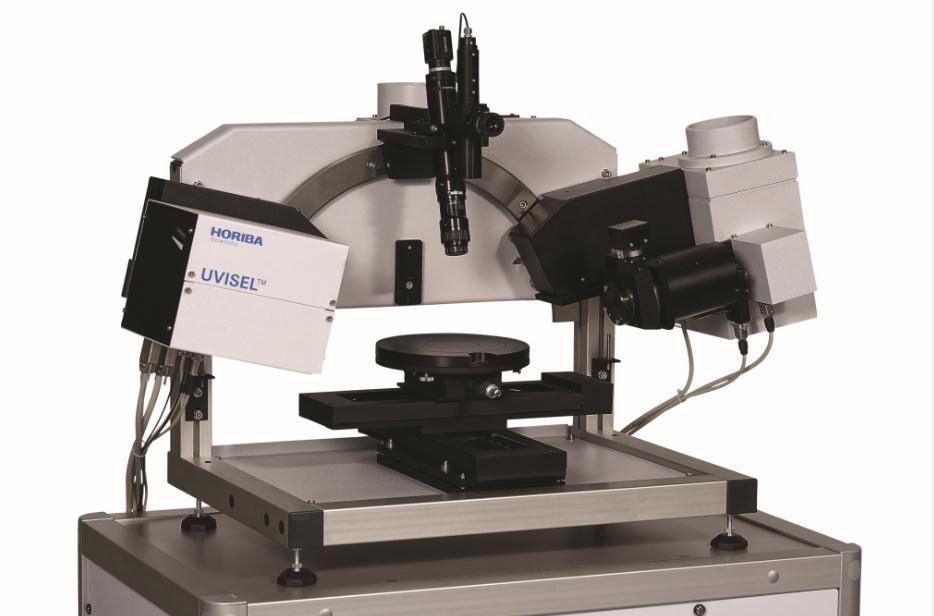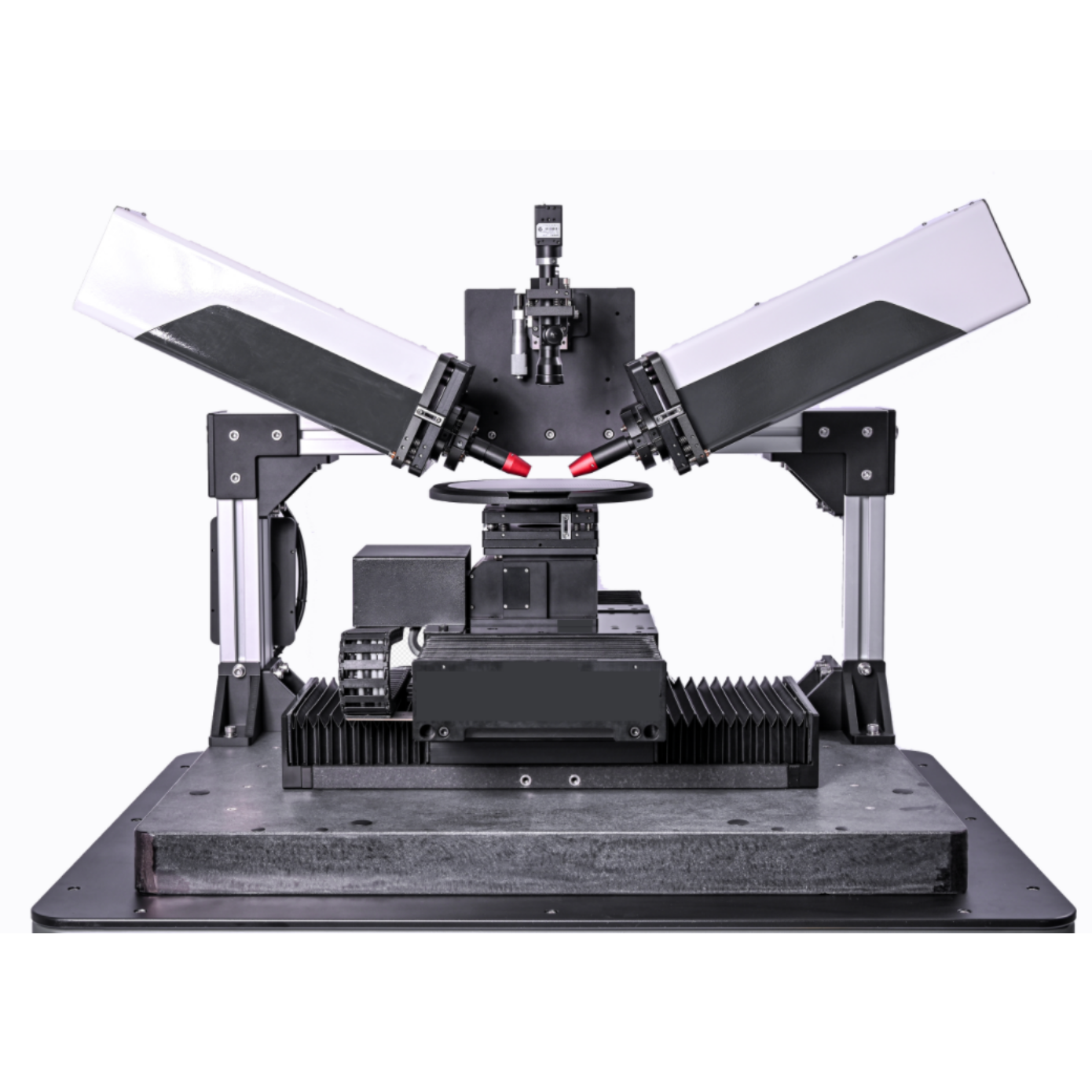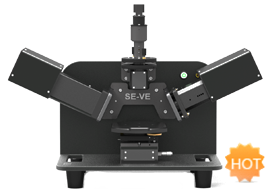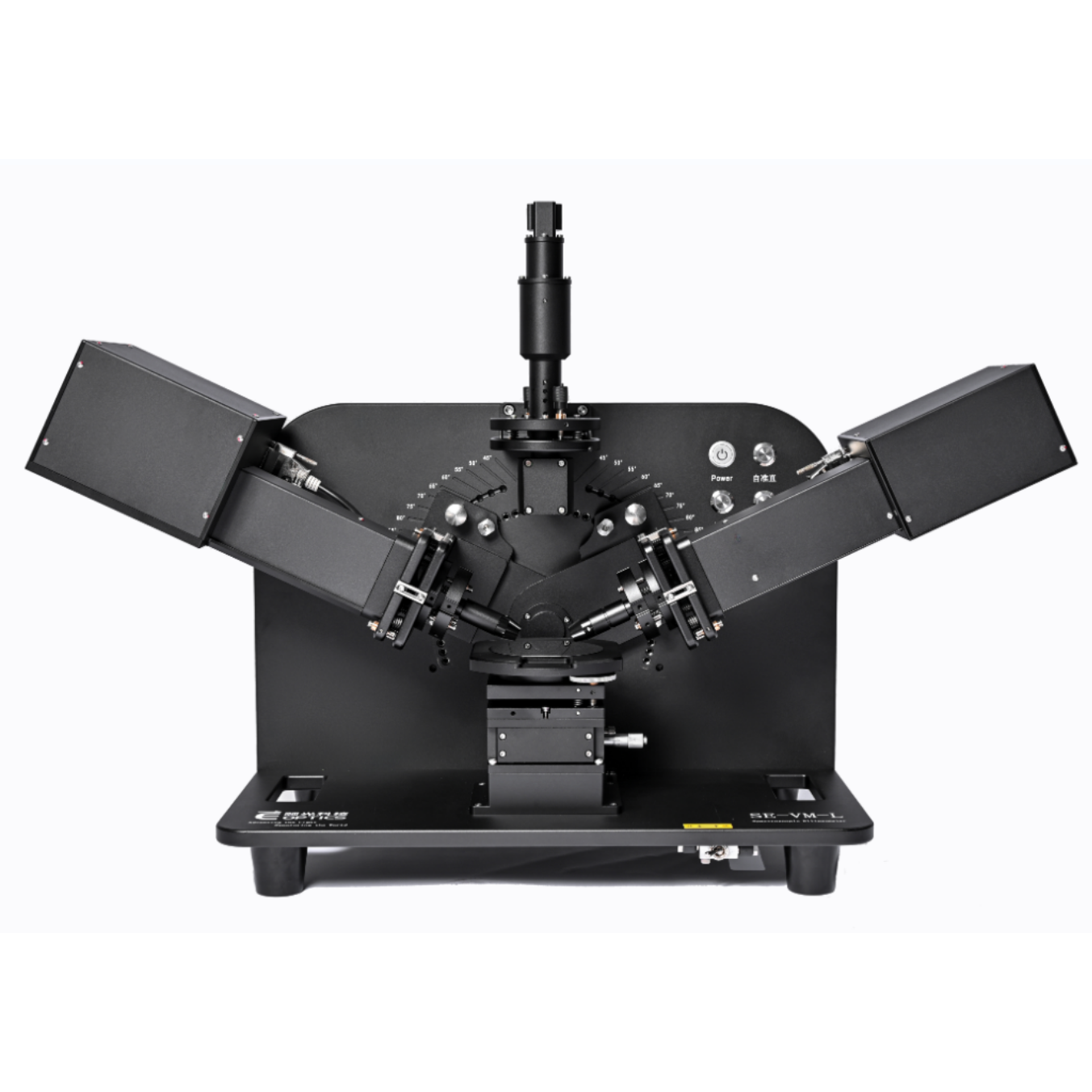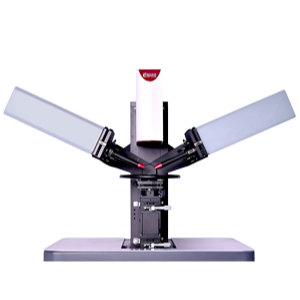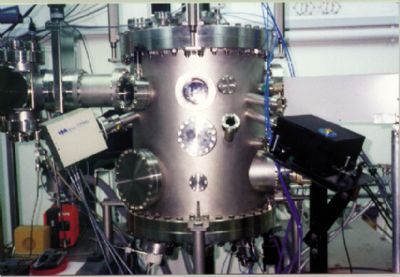方案详情
文
Spectroscopic ellipsometry is a powerful technique for high accuracy characterization of the thickness and optical constants of GeSbTe multilayer systems for rewritable optical disc applications.
It was shown that measurement in the NIR range gives better accuracy for the analysis of these types of material. The use of the multiple sample analysis reduces parameter correlations and errors for the thinnest layers.
Owing to the advanced modelling features included in the DeltaPsi2 software, it is a straightforward procedure to analyze such structures even with layers deposited on both sides of the substrate.
方案详情

Application NofeData StorageUVISELSpeciroscopic Ellipsometry Spectroscopiccopic Ellipsomei Characterization of GeSbTe films by Spectroscopic Ellipsometryfor Rewritable Optical Discs Celine Eypert, Melanie Gaillet - Application Scientists - Thin Film Division Phase change optical recording is a challenging technology for data storage that is used for CD and DVDrewritable discs. It is based on localized laser induced heating of a thin layer to cause a phase transitionfrom the crystalline to amorphous state. This transformation results in optical reflectance differences. Cur-rently phase change rewritable optical discs are mainly based on two tamilies of phase change materials.Pseudo-binary alloys based on GeTe-Sb2Te3 (here referred to as GeSbTe) or quaternary AglnSbTe alloys.The choice of material is governed by the specific requirements of the application. An accurate measurement of the thickness and optical constants of the multilayer system is important be-C echanical, optical and thermal characteristics are influenced by the entire layer structure. Spec-troscopic ellipsometry allows the simultaneous determination of these properties quickly and with highaccuracy. GeSbTe material GeSbTe, or Germanium-Antimony-Tellurium, is a phasechange material trom the group of chalcogenide glassesused in rewritable optical discs and phase-cNhAange mem-ory applications. It is a ternary compound ot germanium,antimony, and tellurium, with composition GeTe-Sb2Te3. ts recrystallization time is around 20 nanoseconds, allow-ing writing bitrates of up to35 Mbit/s, and direct over-write capability up to 10°cycles. During writing, thematerial is first erased by conversion to its crystalline stateoy heating it to its crystallization temperature using rela-tively long, low intensity laser irradiation. After this infor-mation is written onto the crystalline phase by heatingwith short (<10 ns), high-intensity laser pulses. The mate-rial locally melts and is quickly cooled, remaining in theamorphous phase. As the amorphous phase has lowerreflectivity than the crystalline phase, the bitstream can be lrecorded as 《dark》 amorphous spots on the crystallinebackground. Experimental The work was performed using a UVISEL NIR Spectro-scopic Phase Modulated Ellipsometer. The ellipsometricmeasurements were made at an angle of incidence of 75°across the spectral range 0.65-6.5 eV(190-1907nm). The analysis was carried out in the restricted spectralrange 0.65-3 eV. The NIR range is especially useful forthis type of analysis as it contains the most precise infor-mation for characterizing the GeSbTe material. Five different samples with increasingthicknesses ofGeSbTe were characterized. The samples are composedof the phase-change layer containing a GeSbTe alloy de-posited onto a dielectric layer of SiO2, the substrate is c-Si. It is important to notice that the dielectric layer was de-posited on both sides of the substrate. As the measure-ment was performed in the NIR range, it is necessary totake into account the back SiO2 layer in the model be-cause in this range the c-Si is transparent and conse-quently the backside retlections were collected during theexperimental measurement. Analysis of the experimental spectra >The NIR range is sensitive to the presence of the backCcoating ot SiO2. >Sample 1 exhibits interference fringes in the visible as ithas the thinnest GeSbTe thickness. These fringes aredue to the SiO2 layer. Samples 2 to 5 exhibit the same experimental data inthe visible and FUV range. Therefore we can concludethat the NIR range contains the most important infor-mation to analyze the different GeSbTe structures. Characterization of the multilayer system ·Analysis of 5 samples The model below has been used to fit perfectly the fivesamples from 0.65 to 3.0 eV. Note that the model in-cludes a rough overlayer on top for the samples 3 to 5.The rough overlayer is modeled by a mixture of 50% void+ 50% GeSbTe using the effective medium model ap-proximation. The Tauc Lorentz oscillator formula was used to model theoptical constants of the GeSbTe layer. the varying parameters during the itting process were theGeSbTe film thickness and optical constants. The x?rep-resents the goodness of fit parameters. The table below summarizes the results obtained by spec-troscopic ellipsometry analysis for the five samples. Samples d SiO,(A) d GeSbTe(A) d Roughness(A) 1 1008 72±4.386 / 0.14 2 1028 315±22.125 / 0.47 3 1038 450±3.282 38±1.779 0.14 4 1042 935±4.182 43±1.555 0.20 5 1045 1390±5.451 60±2.025 0.26 ·Multiple sample analysis These five samples include the same GeSbTe layer andoptical constants,but have ditterent thicknesses. As a re-sult the analysis of all samples may be performed simulta-neously using the same GeSbTe optical constants coupledacross the five models. The report below presents the analysis results for the fivemodels (called M1 to M5). One set of optical constantshas been determined in addition to the thickness of eachfilm. As expected the uncertainty between the analyses is foundto be larger for the first two samples. The multiple sampleanalysis has the advantage ot reducing the parameter cor-relations and error bars, especially for samples 1 and 2. X2==0.925213 M1一L4Thickness [A = 80.451±0.518 M2 -L4 Thickness A1 = 292.929 土1.864 M3 -L4 Thickness A]= 482.184 3.541 M3 -L5 Thickness [A] = 19.697 土1.141 M4 L4 Thickness [A] = 966.349 ±4.620 M4一L5 Thickness [A1 = 27.001 ±1.069 M5 L4 Thickness [A] = 1443.513 ±4.736 M5-L5 Thickness [A] = 33.975±0.874 GST-l1_tl Eg= 0.4769404 ±0.0034467 GST-1tl eo= 2.0008680 ±0.0854438 GST-1tl A= 159.4244000 ±1.6960020 GST-1tl Eo = 1.5492960 ±土 0.0069694 GST-1_tl C = 2.2299040 ±± 0.0095840 Conclusion Spectroscopic ellipsometry is a powerfultechnique forhigh accuracy characterization of the thickness and opti-cal constants of GeSbTe multilayer systems for rewritableoptical disc applications. It was shown that measurement in the NIR range givesbetter accuracy tor the analysis ot these types ot material.The use of the multiple sample analysis reduces parame-ter correlations and errors tor the thinnest layers. Owing to the advanced modelling features included inthe DeltaPsi2 software, it is a straightforward procedure toanalyze such structures even with layers deposited onboth sides of the substrate. USA: +1-732494 8660France: +33 (0)1 64 54 1300Germany: +49 (0)89 462317-0UK:+44(0)20 8204 8142China: +86 (0)1068492216 ( Japan: +8 1 (0 ) 3 38 6 18231 I t aly : +3 90257 6 03050 ) Other Countries: +33 (0)1 64 54 13 00 HORIBAExplore the future HORIBAJOBIN YVONFind us at www.jobinyvon.com or telephone:HORIBAExplore the future Spectroscopic ellipsometry is a powerful technique for high accuracy characterization of the thickness and optical constants of GeSbTe multilayer systems for rewritable optical disc applications.It was shown that measurement in the NIR range gives better accuracy for the analysis of these types of material. The use of the multiple sample analysis reduces parameter correlations and errors for the thinnest layers.Owing to the advanced modelling features included in the DeltaPsi2 software, it is a straightforward procedure to analyze such structures even with layers deposited on both sides of the substrate.
确定

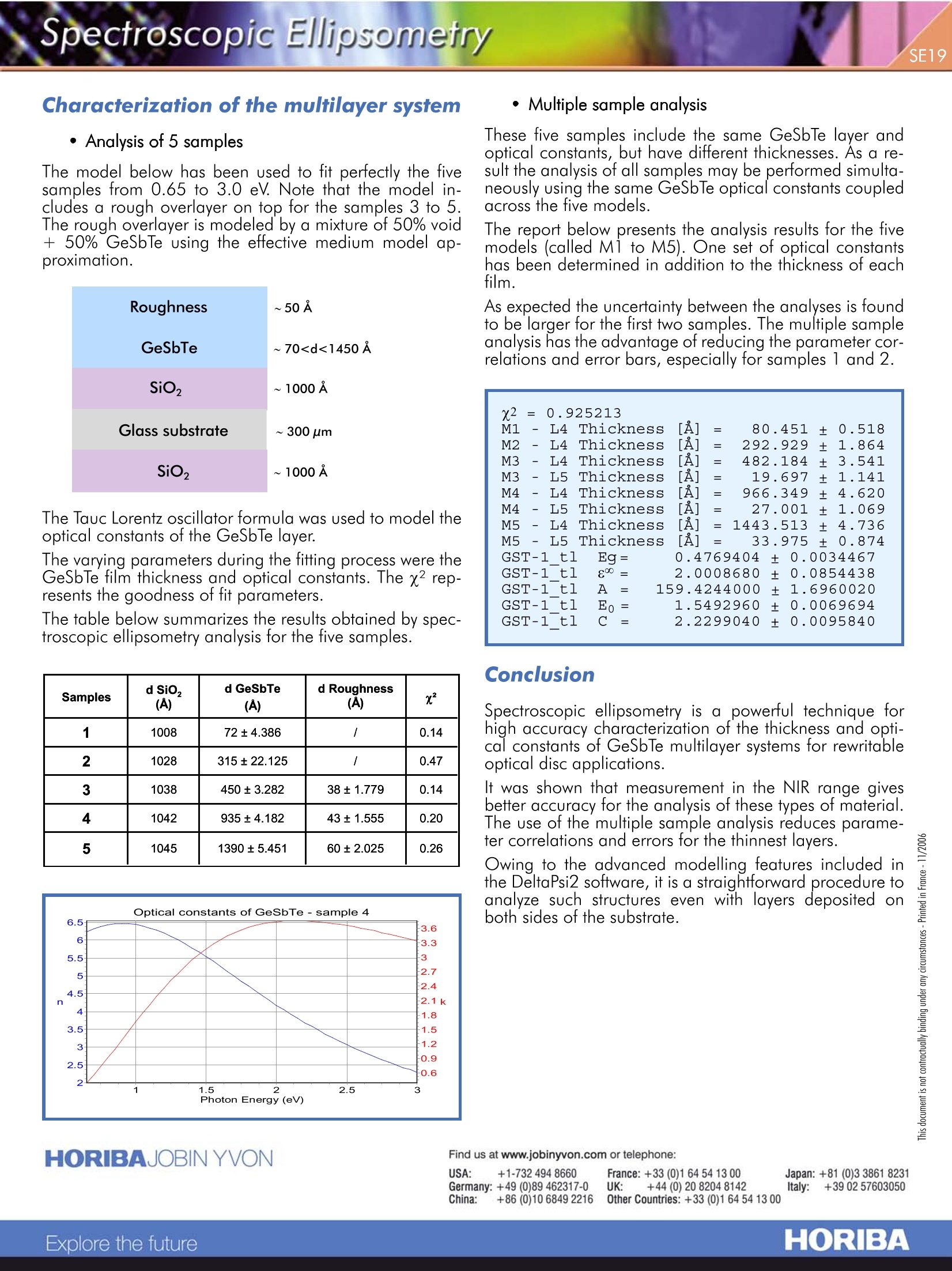
还剩1页未读,是否继续阅读?
HORIBA(中国)为您提供《GeSb膜中厚度,光学常数检测方案(椭偏仪)》,该方案主要用于其他中厚度,光学常数检测,参考标准--,《GeSb膜中厚度,光学常数检测方案(椭偏仪)》用到的仪器有HORIBA UVISEL Plus研究级经典型椭偏仪
推荐专场
相关方案
更多
该厂商其他方案
更多

